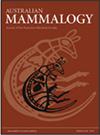Habitat use over winter by short-beaked echidnas (Tachyglossus aculeatus) at an intermittently flowing creek in arid north-western New South Wales
IF 1.2
4区 生物学
Q3 ZOOLOGY
引用次数: 0
Abstract
The heterogeneity of resource distribution in arid environments plays an important role in habitat selection by consumers. The productivity of the riparian zones of intermittently flowing creeks is typically prolonged, relative to the hinterland, as moisture and nutrients concentrate there. Short-beaked echidnas, Tachyglossus aculeatus, sustain arid populations, attributed to ant and termite availability, low predation, and an ability to exploit habitat remnants. However, the scale of their movements in arid habitats is poorly understood. Thus, we investigated echidna home ranges and the importance of food and shelter availability in habitat selection over one winter. We focussed on the riparian zone of a creek at Mount Wood in Sturt National Park, north-western New South Wales, Australia. Radio tracking (VHF and GPS), scat and habitat selection analyses were conducted. Mean core and peripheral home range areas were 0.16 and 1.042 km2, respectively, with a mean home range overlap of 0.56 km2. Habitat selection differed between juveniles and adults and may have been driven by prey availability (predominantly ants). The preferred shelter was thick leaf litter. We concluded that habitat selection patterns were driven by prey availability (ants) and shelter (leaf litter).在干旱的新南威尔士州西北部,短喙针鼹(Tachyglossus aculeatus)在一条间歇流动的小溪中过冬
干旱环境中资源分布的异质性对消费者的生境选择起着重要作用。相对于内陆地区,间歇流动的小溪的河岸地带的生产力通常较长,因为那里集中了水分和营养物质。短喙针鼹,Tachyglossus aculeatus,维持干旱种群,归因于蚂蚁和白蚁的可用性,低捕食率和利用栖息地残留物的能力。然而,人们对它们在干旱栖息地的活动规模知之甚少。因此,我们在一个冬天调查了针鼹的栖息地范围以及食物和住所的可用性在栖息地选择中的重要性。我们关注的是澳大利亚新南威尔士州西北部斯特国家公园伍德山的一条小溪的河岸地带。进行了无线电跟踪(VHF和GPS)、粪便和生境选择分析。平均核心和外围居住范围分别为0.16和1.042 km2,平均居住范围重叠0.56 km2。幼蚁和成虫的栖息地选择不同,这可能是受猎物(主要是蚂蚁)的影响。首选的遮蔽物是厚厚的落叶。我们得出结论,栖息地选择模式是由猎物(蚂蚁)和庇护所(落叶)驱动的。
本文章由计算机程序翻译,如有差异,请以英文原文为准。
求助全文
约1分钟内获得全文
求助全文
来源期刊

Australian Mammalogy
ZOOLOGY-
CiteScore
2.50
自引率
8.30%
发文量
26
期刊介绍:
Australian Mammalogy is a major journal for the publication of research in all branches of mammalogy. The journal’s emphasis is on studies relating to Australasian mammals, both native and introduced, and includes marine mammals in the Antarctic region. Subject areas include, but are not limited to: anatomy, behaviour, developmental biology, ecology, evolution, genetics, molecular biology, parasites and diseases of mammals, physiology, reproductive biology, systematics and taxonomy.
Australian Mammalogy is for professional mammalogists, research scientists, resource managers, consulting ecologists, students and amateurs interested in any aspects of the biology and management of mammals.
Australian Mammalogy began publication in 1972 and is published on behalf of the Australian Mammal Society.
 求助内容:
求助内容: 应助结果提醒方式:
应助结果提醒方式:


